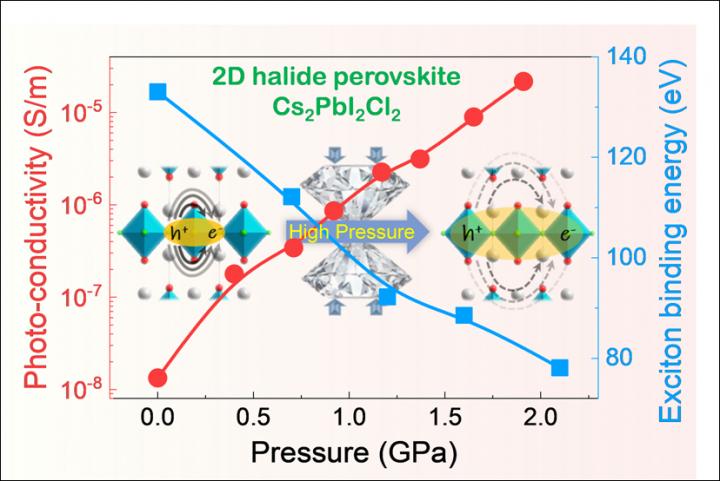
Credit: Xujie Lü
HPSTAR scientists Dr. Songhao Guo and Dr. Xujie Lü report three orders of magnitude increase in the photoconductivity of Cs2PbI2Cl2 from its initial value, at the industrially achievable level of 2 GPa, using pressure regulation. Impressively, pressure regulating the 2D perovskite’s excitonic features gains it 3D compound characteristics without diminishing its own advantages, making it a more promising material for photovoltaic and photodetector applications. Their study is published as a Cover article in the latest issue of the Journal of the American Chemical Society.
Two-dimensional (2D) halide perovskites have recently emerged for photovoltaic and optoelectronic applications due to their unique and tunable properties as well as high stability. Despite substantial development progress on developing these materials, how structural regulation affects their excitonic features, which govern their optoelectronic properties, has been unknown until now.
Comprehensive in situ experimental characterization and first-principles calculations reveal that lattice compression effectively regulates the excitonic features of Cs2PbI2Cl2, reducing the exciton binding energy from 133 meV at ambient conditions to 78 meV at 2 GPa. Notably, this reduced exciton binding energy of the 2D perovskite is comparable to typical 3D halide perovskites’ values, facilitating the dissociation of photo-excited excitons into free carriers and thus, enhancing the photoconductivity. Further pressurization leads to a layer-sliding-induced phase transition and an anomalous negative-linear compression, which has never been observed in other halide perovskites.
This work reveals the pressure-enhanced photocurrents in 2D halide perovskite for the first time and provides deeper insights into the relationship between their excitonic features and optoelectronic properties, furthering our understanding of their fundamental mechanisms.
###
More information: “Enhanced Photocurrent of All-Inorganic Two-Dimensional Perovskite Cs2PbI2Cl2 via Pressure-Regulated Excitonic Features”, Songhao Guo et al., J. Am. Chem. Soc., doi.org/10.1021/jacs.0c11730 (2021).
Media Contact
Haini Dong
[email protected]
Original Source
http://hpstar.
Related Journal Article
http://dx.




